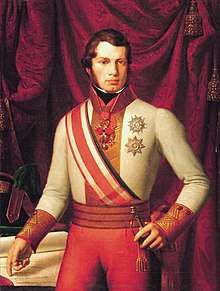Pietro Benvenuti
Pietro Benvenuti (8 January 1769 – 3 February 1844) was an Italian neoclassical painter.

Biography
Born in Arezzo in Tuscany, he was influenced by the style of Jacques-Louis David. He was a student of the Academy of Fine Arts of Florence, then studied in Rome, 1792–1803, where he formed an informal academy with his friend of long standing, Vincenzo Cammuccini, and Luigi Sabatelli. He returned to practice in Arezzo.
With a group of collaborators and students Benvenuti was commissioned in 1811–12 to decorate the new rooms in Palazzo Pitti, where he painted a series of mythologic scenes for the Salon of Hercules on the Greek demigod. Another prestigious commission, from the restored Grand Duke of Tuscany, Leopold II, was to fresco the dome of the Capella Medicea at the San Lorenzo, depicting eight grand subjects, taken from the Old and the New Testament, the four Prophets and the four Evangelists. Under his guidance, Carlo Lasinio engraved the Luca Giordano frescoes in Palazzo Medici-Riccardi.
He was an associate of the Accademia di Brera, Milan. In 1829, he was elected into the National Academy of Design as an Honorary member.
In 1807 he was recruited to become court painter to Elisa Bonaparte Baciocchi and to direct the Florentine Academy of Fine Arts. He died at Florence, while holding the post of Director. In that position, he had many pupils and students, including Giuseppe Bezzuoli, Gaspero Martellini, Tomasso Gazzarini, Niccola Cianfanelli,[1] Luigi Mussini, and Giorgio Berti.
He should not be confused with the 16th-century architect Pietro Benvenuto degli Ordini.
Gallery
 The Death of Priam, 1811
The Death of Priam, 1811

 Christ and the Samaritan, ca. 1807
Christ and the Samaritan, ca. 1807
References
- Saltini, Guglielmo Enrico (1862). Le Arti Belle in Toscana da Mezzo il Secolo VIII ai di Nostri, Memoria Storica.. Florence, Italy: Tipografia Le Monnier. pp. 50–51.
External links
| Wikimedia Commons has media related to Pietro Benvenuti. |
- Athena, Hercules and Cupid by Pietro Benvenuti, in Palazzo Pitti, Florence
- Toscana Europa: Pietro Benvenuti
- Rollins Willard, Ashton (1900). History of Modern Italian Art. Longmans, Green & co., 39 Paternoster Row, London; Digitized by Googlebooks. pp. 278–282.
- Bryan, Michael (1886). Robert Edmund Graves (ed.). Dictionary of Painters and Engravers, Biographical and Critical (Volume I: A-K). York St. #4, Covent Garden, London; Original from Fogg Library, Digitized May 18, 2007: George Bell and Sons. p. 112.CS1 maint: location (link)